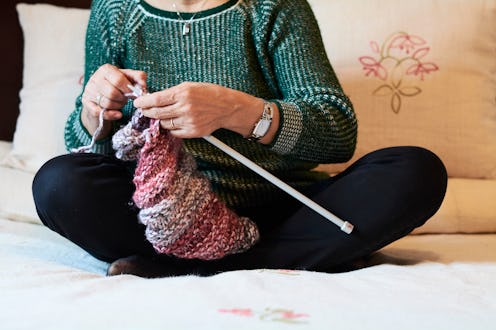Life
Experts Explain How Making Art While You’re Stuck At Home Can Help Mental Health

With so many people stuck in their houses practicing social distancing, nearly everyone is under-stimulated and overstressed. One way to to help your mental health while you're at home, experts say, is to create some art — literally, any kind. Whether you pick up a paintbrush, write out your feelings in a journal, decorate cakes, or do a spontaneous dance around the kitchen, artistic expression can be very helpful for mental health.
"Nearly any creative activity can become therapeutic," Dr. Gregory Nawalanic Pys.D., clinical psychologist with the University of Kansas Health System, tells Bustle. And, importantly, it doesn't matter if you feel you have any talent; you could be the next Mozart or just barely manage to remember where C is on the keyboard, and you'll likely feel some benefit.
"It can be useful to have a toolkit of coping skills to help calm the nervous system — and that's where art comes in," art therapist Cassie Hamrick, ATR LCMHC, tells Bustle. They explain that art has been shown to help regulate the nervous system through mind-body engagement; when you draw, you direct your body to hold the pencil, and your mind to direct your hand's movement. "This type of focused, embodied movement can help activate the parasympathetic wing of our nervous system, which sends calming signals throughout the brain and body," they say. This is why you feel calm and focused as you color in a picture or concentrate on a guitar chord.
Science backs it up. A review of studies on art and health published in the American Journal of Public Health in 2010 found that doing some form of artistic activity improves wellbeing and feelings of self-worth, relieves symptoms of anxiety and depression, and reduces stress. A report by the World Health Organization in 2019 also found that practicing art can help you cope and regulate your emotions, and reduce loneliness.
Art can also help us express feelings we don't have words for. "Art, writing, and music are all great creative outlets to help pass the time, as they provide an outlet to express the feelings we might not be able to effectively, or even politely, verbalize in the moment," Dr. Nawalanic says. Artistic space can be quiet, calm, and accepting, allowing you to be vulnerable and do and say what you feel.
Creating art can be therapeutic in its escapism, too. "When any combination of heart, mind and body are truly engaged at a deep level, we slip into a state that is beyond reality," psychotherapist Karen Koenig, LCSW, M.Ed., tells Bustle. This escape can be really helpful for anybody who's feeling really confined by the four walls of their apartment right now. "Throw your heart and soul into a creative endeavor just for the pure fun of it," Koenig says — the escape can help you recalibrate and feel relief.
Whatever artistic practice you pursue, it can also provide motivation: Koenig says that art can give people something to look forward to each day, and fresh achievements to celebrate. "We can set goals for personal growth through learning to play an instrument or add new songs to the repertoire," Dr. Nawalanic says. Every goal you meet is a chance to feel good about yourself.
If you'd like to explore using art as a way to deal with issues in therapy, Hamrick says you should find a qualified art therapist. "Art therapists are trained in psychotherapy and counseling techniques, centering art as a method of healing," they say. But they also point out that anybody can use art to help their mental health at home. "We know that creative expression has always been a tool that humans have used for wellness and survival. You do not have to 'be an artist' to benefit."
Studies cited:
Abbing A, de Sonneville L, Baars E, Bourne D, Swaab H (2019) Anxiety reduction through art therapy in women. Exploring stress regulation and executive functioning as underlying neurocognitive mechanisms. PLOS ONE 14(12): e0225200. https://doi.org/10.1371/journal.pone.0225200
Haiblum-Itskovitch S, Czamanski-Cohen J, Galili G. Emotional Response and Changes in Heart Rate Variability Following Art-Making With Three Different Art Materials. Frontiers in Psychology. 2018 ;9:968. DOI: 10.3389/fpsyg.2018.00968.
Stuckey, H. L., & Nobel, J. (2010). The connection between art, healing, and public health: a review of current literature. American journal of public health, 100(2), 254–263. https://doi.org/10.2105/AJPH.2008.156497
Fancourt, D. & Finn, S. (2019) Health Evidence Network synthesis report 67: What is the evidence on the role of the arts in improving health and well-being? A scoping review. World Health Organization.
Experts:
Cassie Hamrick ATR LCMHC, art therapist
Karen Koenig LCSW M.Ed, psychotherapist
Dr. Gregory Nawalanic Pys.D., psychologist, University of Kansas
This article was originally published on